John Steen passed away in November 10, 2007 and, sadly, never knew of the renewed popularity of his TACO Mini Bikes. John had been living in Mexico for the last 15 years and only moved back to the states to San Diego after discovering he had cancer.
The history of John Steen’s TACO Mini Bikes would have been lost without the help of Lynn Wineland. Lynn was a long time friend and employee of John Steen, but not just any employee. Not only did Lynn help John market his STEEN’S C synthetic oil back in the late 50’s, he was the graphic designer for the STEEN’S catalogs and helped design some of the TACO mini bikes. One of Lynn’s greatest contributions to the TACO mini bikes was coming up with the actual Metallic Purple color.
Another person to help put the pieces back together is Donal Jolley who worked with Lynn at ROD and CUSTOM as a graphic artist. Donal’s two biggest contributions were the Mexican Bean riding the TACO and the TACO lettering.
Jack Poet is one more original STEEN’S employee who has helped us put the puzzle of 60’s So Cal history back together. Jack became STEEN’S shop foreman around 1966 and designed most of the TACO’s, along with Lynn Wineland, that we are all familiar with, like the TACO44, TACO99, and TACO100.
Some of the picture you will see were provided by Ed Kretz Jr. is a AMA Grand National Champion of the 1950s and AMA Motorcycle Hall of Famer, and Susan Steen Barr, John Steen's Daughter.
Thank you Lynn Wineland, Donal Jolley, Jack Poet, Ed Kretz Jr. and Susan Steen Barr for all your help in saving a little bit of
So Cal history.

“The History of STEEN’S Chemical and Lubricants Company”

In the Beginning
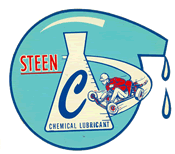 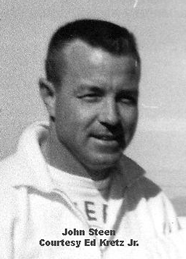 This is the history of STEEN’S Chemical and Lubricants Company. A So-Cal company in the 60’s that (by all accounts) made and sold the first synthetic oil in America, not to mention creating one of the greatest 60’s mini bike brands of all time, the This is the history of STEEN’S Chemical and Lubricants Company. A So-Cal company in the 60’s that (by all accounts) made and sold the first synthetic oil in America, not to mention creating one of the greatest 60’s mini bike brands of all time, the  . John Steen created the company in the late 50’s by selling used speed equipment and the synthetic oil formulated by his father in the 40’s while working for Standard Oil as a chemist. Prior to this in the early 50’s, John Steen was an off road motorcycle rider. John rode with legendary riders Ed Kretz Jr., Cliff Coleman, Dave and Bud Ekin and Steve McQueen and others. These are some of the guys who created the Motocross sport on the west cost. Around this time, John’s Dad passed away leaving him his formula for synthetic oil. (One side note: You would think that with John’s Dad working for Standard Oil, they would own the formula for synthetic oil. Well they did, but they told him that they were in the oil business not the synthetic oil business and he could have the formula. So John’s Father took it.) John talked to Union Carbide and worked out a deal to start making small amounts of this synthetic oil and asked people he knew to try it. Some people known to try STEENS C were: . John Steen created the company in the late 50’s by selling used speed equipment and the synthetic oil formulated by his father in the 40’s while working for Standard Oil as a chemist. Prior to this in the early 50’s, John Steen was an off road motorcycle rider. John rode with legendary riders Ed Kretz Jr., Cliff Coleman, Dave and Bud Ekin and Steve McQueen and others. These are some of the guys who created the Motocross sport on the west cost. Around this time, John’s Dad passed away leaving him his formula for synthetic oil. (One side note: You would think that with John’s Dad working for Standard Oil, they would own the formula for synthetic oil. Well they did, but they told him that they were in the oil business not the synthetic oil business and he could have the formula. So John’s Father took it.) John talked to Union Carbide and worked out a deal to start making small amounts of this synthetic oil and asked people he knew to try it. Some people known to try STEENS C were:
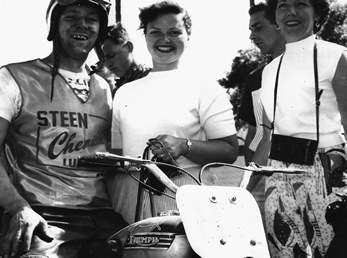 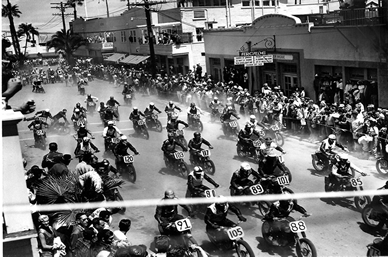
Ed Kretz Jr. 1956 Catalina Grand Prix
Ed Kretz Jr. who ran it in his Triumph Cub in 1956 at the Catalina Grand Prix and won. Ed claims that it held the engine together and the engine never ran smoother.
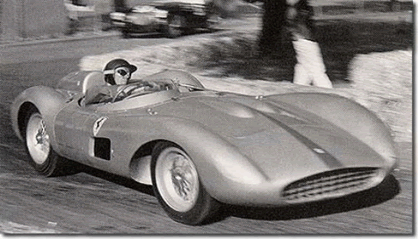 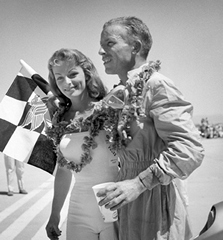
Richie Ginther ran STEENS C in his Ferrari 250 GT in 1958 at the SCCA Palm Springs race. Richie was in the lead with two laps left when unknowingly ripped off the drain plug from the engine losing all his synthetic oil. Richie finished the race and won and when they tore down the engine to check the damage there was none. John claimed that there were three types of oil, “Green oil, Castro Bean oil, and STEEN’S oil”.

Making Rent in Alhambra
Some time in the late 50’s John was involved in a motorcycle accident and injured himself enough that he had to get out of dirt bike racing. John is definitely not in a good place at this time. He starts working for the Los Angeles Harold Examiner delivering news papers to distribution stations for delivery to news stands and homes. Worse, John is now homeless and sleeping in his delivery truck. John is very well known at this point 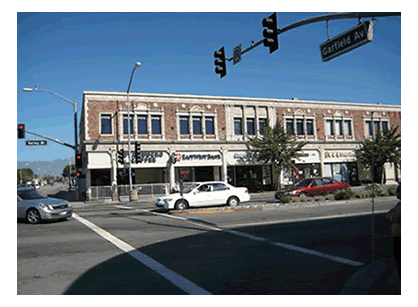 with all of the west coast motorcycle riders and Hot Rodders of the day. Some of his friends at this time were the guys at Webco motorcycle accessories; Tom Heininger, Bob Hughes, and Harry Weber. Their Business was located at 19 East Valley Blvd. Alhambra California (Soon to be STEEN’S location #1). Webco had moved to Venice Beach but they had two weeks left on the rent at the Alhambra location. They told John he could move in for the two weeks and if he could get something going he could take over the lease. John moved in and started selling used speed equipment for motorcycles and cars. The speed equipment came from all the people he knew from the west cost Motorcycle and Hot Rod community at the time. Motorcycle racers and Hot Rodders would bring their used parts and equipment to John and he would sell it on consignment through the store. It was from these sales and $60 dollars in dimes collected in a milk bottle that John made his first months rent. Of course, John was also selling his STEEN’S C synthetic oil along with all this used speed equipment. John is now on his way to making rent month to month, but there is one big moment to come that will really get things going. with all of the west coast motorcycle riders and Hot Rodders of the day. Some of his friends at this time were the guys at Webco motorcycle accessories; Tom Heininger, Bob Hughes, and Harry Weber. Their Business was located at 19 East Valley Blvd. Alhambra California (Soon to be STEEN’S location #1). Webco had moved to Venice Beach but they had two weeks left on the rent at the Alhambra location. They told John he could move in for the two weeks and if he could get something going he could take over the lease. John moved in and started selling used speed equipment for motorcycles and cars. The speed equipment came from all the people he knew from the west cost Motorcycle and Hot Rod community at the time. Motorcycle racers and Hot Rodders would bring their used parts and equipment to John and he would sell it on consignment through the store. It was from these sales and $60 dollars in dimes collected in a milk bottle that John made his first months rent. Of course, John was also selling his STEEN’S C synthetic oil along with all this used speed equipment. John is now on his way to making rent month to month, but there is one big moment to come that will really get things going.

Acceleration of STEEN’S C
Going back to September 1956, Art Ingles who worked for Indianapolis car builder Frank Kurtis in Glendale built what was going to be the first GoKart.
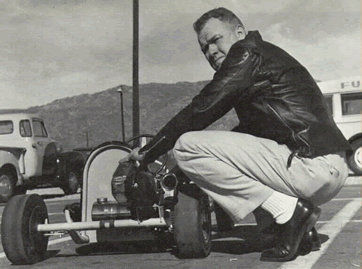 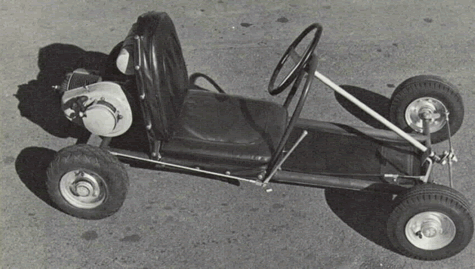
Art Ingels The first GoKart
In 1957 after seeing Art Ingles’ one-off creation, Duffy Livingston and Roy DeBrow of GP Muffler Services in Monrovia California built their own version. Bill Rowles, then a salesman of surplus materials in the L.A. area, was a frequent visitor at the GP Muffler shop. Bill had located a source of inexpensive engines from a failed West Bend and McCulloch rotary lawn mower venture.
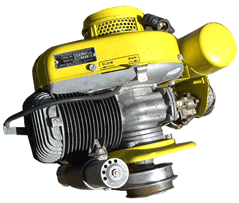 The engines cost about $5 each. The engine did have one small problem, the seal on the crank shaft would come lose causing the crank to brake right where the lawn mower blade was attached. This caused the blade to brake lose and fly free, sometimes into the ankle of the lawn mower operator. Hearing about STEEN’S C synthetic oil, the guys at GP Mufflers talk to John about their small engine and wondered if it would work for them. John told them that if they used STEEN'S C synthetic oil the engine would hold together and run better. They tried the STEEN’S C and the engines held together. In late 1957 the popularity of the little car (Lynn Wineland still hasn’t named the “GoKart” yet in Rod & Custom.) was so great that Duffy, Roy, and Bill formed a partnership to manufacture and sell 50 little car kits for $129 dollars each. At the same time the guys asked commercial artist Lynn Wineland, who hung around GP Mufflers and was working at Rod and Custom, to come up with a mail order ad for the little car. The engines cost about $5 each. The engine did have one small problem, the seal on the crank shaft would come lose causing the crank to brake right where the lawn mower blade was attached. This caused the blade to brake lose and fly free, sometimes into the ankle of the lawn mower operator. Hearing about STEEN’S C synthetic oil, the guys at GP Mufflers talk to John about their small engine and wondered if it would work for them. John told them that if they used STEEN'S C synthetic oil the engine would hold together and run better. They tried the STEEN’S C and the engines held together. In late 1957 the popularity of the little car (Lynn Wineland still hasn’t named the “GoKart” yet in Rod & Custom.) was so great that Duffy, Roy, and Bill formed a partnership to manufacture and sell 50 little car kits for $129 dollars each. At the same time the guys asked commercial artist Lynn Wineland, who hung around GP Mufflers and was working at Rod and Custom, to come up with a mail order ad for the little car.
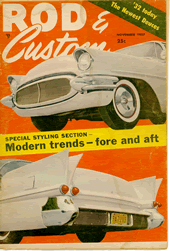 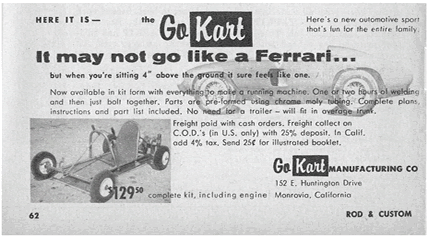
This is the moment when Lynn actually names GP’s little car the “GoKart” in a mail order ad in the November 1957 issue of Rod and Custom. By 1958 the business and hobby had exploded overnight and so did STEEN’S C synthetic oil.
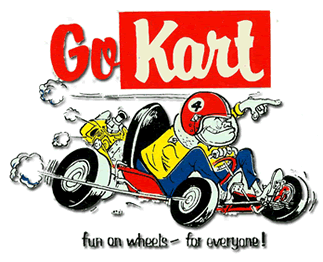 
The GoKart is now selling so fast that the guys move out of the GP Muffler shop and start the GoKart Mfg Company. They lease a five-acre facility in Azusa California from Aero Jet General Corporation. GoKart Mfg. becomes the leader of this new hobby and STEEN’S C becomes the necessary accessory for these fast revving 2 stroke engines if you wanted to win races. John now needs to start mass marketing and packaging his STEEN’S C synthetic oil. He turns to Lynn Wineland who was suggested to him by the boys at GoKart. Lynn designs a new 1qt. can for STEEN’S C and an ad campaign for his new synthetic oil.

Birth of the Mini Cycle
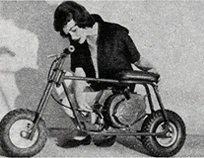
The GoKart world is born and it’s on fire. John is selling a lot of STEEN’S C oil, but something else is about to happen. A few of the guys; Lynn Wineland, Duffy Livingston, Tom Person, Micky Rupp, Chuck Swanson and others, started building small two wheel cycles with the same 2 stroke engines.
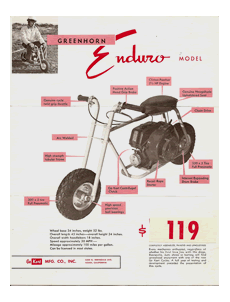 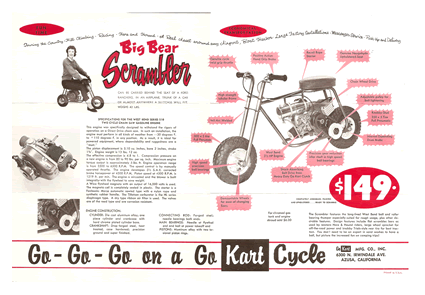 The guys at GoKart Mfg. start building two models of their own to sell. Their standard model was the Enduro Greenhorn powered by the Clinton A400 2 stroke and their deluxe model was the Big Bear Scrambler powered by the West Bend 580 2 stroke. They start mass-producing these Mini Cycles. GoKart Mfg. is by far the manufacturing giant of GoKarts and Mini Cycles at this time and John is selling more and more of STEEN’S C. The guys at GoKart Mfg. start building two models of their own to sell. Their standard model was the Enduro Greenhorn powered by the Clinton A400 2 stroke and their deluxe model was the Big Bear Scrambler powered by the West Bend 580 2 stroke. They start mass-producing these Mini Cycles. GoKart Mfg. is by far the manufacturing giant of GoKarts and Mini Cycles at this time and John is selling more and more of STEEN’S C.
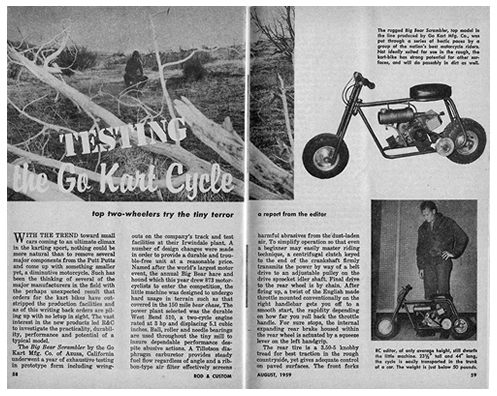 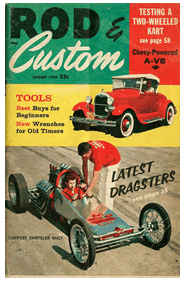 By August of 1959 Rod and Custom were the first to take notice of the Mini Cycle, just like they did with the GoKarts. Since Lynn Wineland is the Art Director of Rod and Custom he did an entire article on the new GoKart Cycle and this new hobby. This might actually be the first article about Mini Bikes, but the little two-wheel vehicle still is unnamed as a hobby. Most of the Mini Cycles are named after their manufactures with the word cycle added to the end of the name. The Mini Bike was almost named the Mini Cycle because of this trend. By August of 1959 Rod and Custom were the first to take notice of the Mini Cycle, just like they did with the GoKarts. Since Lynn Wineland is the Art Director of Rod and Custom he did an entire article on the new GoKart Cycle and this new hobby. This might actually be the first article about Mini Bikes, but the little two-wheel vehicle still is unnamed as a hobby. Most of the Mini Cycles are named after their manufactures with the word cycle added to the end of the name. The Mini Bike was almost named the Mini Cycle because of this trend.

By 1960 John is now fit enough and misses dirt bike riding so much he starts to ride again and eventually he gets back in to competition dirt biking again on the weekends and is back out in the deserts of Palmdale, Lancaster and the mountains of Big Bear running in “Hare and Hounds”, and “Hare and Scramble” races. John is also sponsoring a lot of these events with his STEEN’S C oil Lynn is also out there but in more of a photojournalist and organizer for the Motorcycle and Mini Cycle race events.

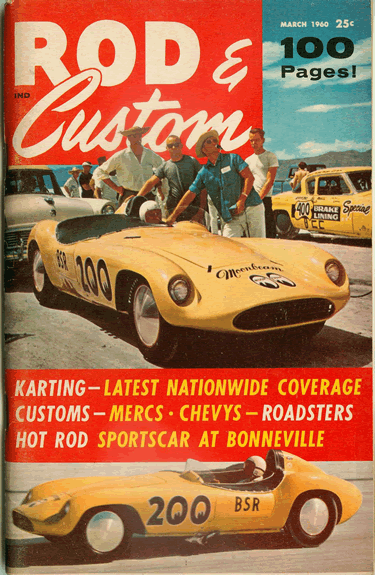 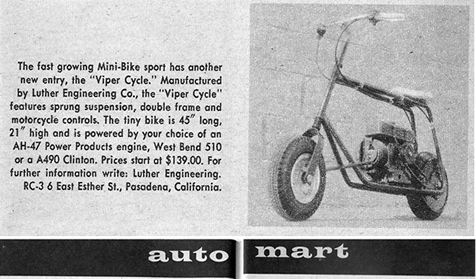
In March 1960 Rod and Custom’s new product section “Auto Mart” highlighted the Viper Cycle. This might be the first time the name Mini Bike is used to describe this new hobby in print.
Motorcycling, GoKarting, Midgets, and Mini Cycles are so hot that small companies start popping up all over the country making all kinds of parts and accessories for these new weekend toys.
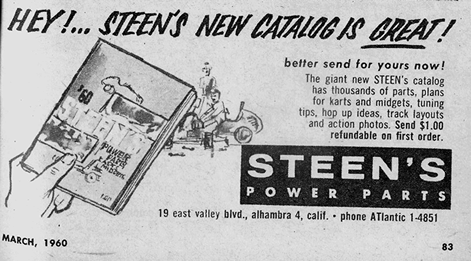
John decides that he should sell all the speed and accessory parts for these new vehicles in one catalog and of course John enlisted Lynn’s help to design the first catalog. Lynn is still working at Rod and Custom, but now he is the Editor of the magazine. Lynn is too busy to work on the new STEEN’S catalog full time so he hiresTom Ulher the graphic editor of Rod and Custom as a freelance graphic artist to help out.
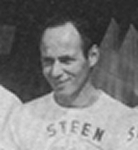
Tom Ulher
(Side note: the only complete GoKart and Mini Cycle that the STEEN’S catalog offers was the GoKart Mfg. vehicles.)
With all of these new Mini Cycles popping up racing came to everybodies mind. We’re not sure who came up with the idea to have a race‚ but Lynn Wineland was still working at Rod & Custom, created a full page ad announcing The first big west coast Mini Cycle race in July of 1960 “ The Tiny Bear”. The Tiny Bear race was named after the Big Bear Scrambler race and was held at Vincent Junction, off the California Hyw. 14. A motorcycle race which started at Vincent Junction and ran through the desert and all the way up the mountains to Fawnskin, Big Bear Lake.
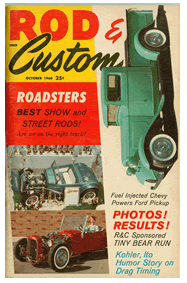 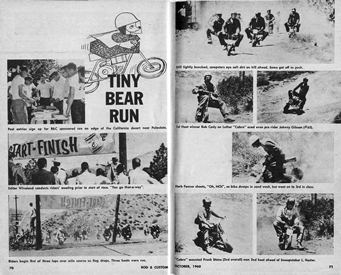
Rod and Custom did a whole story on the race in their Oct. 1960 issue. Micky Rupp came from the east coast to run the race. Some of the other guys who ran the race were Chuck Pelly, Larry Hester, Tom Person, Charles Swanson and others. This is the race that actually started the Mini Bike movement. More and more guys start to build and ride these new Mini Cycles. Some of the earliest models were GoKart Cycle, L’il Indian, Skat Kitty, Falco Caper Cycle, Dart Cycle, Viper Cycle, Savage Scooter, and the 500 Club.
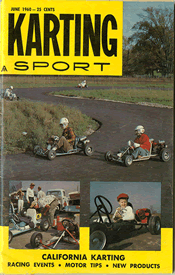 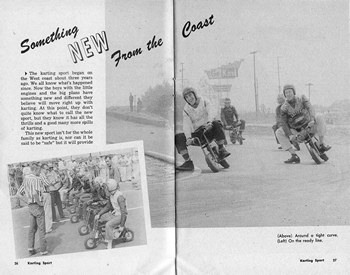
In June 1960 Karting Sport writes the third article announcing this new Hobby and sport, but still the article states no name yet.
Business is growing so fast that John has out grown STEEN’S location #1 (19 East Valley Blvd)
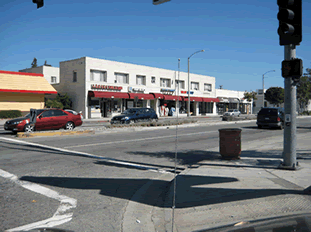
and moves to STEEN’S location #2 (939 West Valley Blvd.)

Mini Bikes
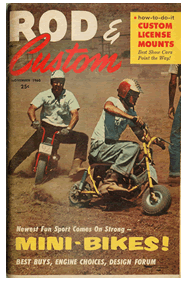 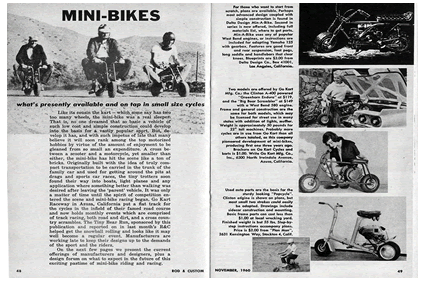
November 1960 Lynn Wineland and Rod and Custom use the term Mini Bike in an extensive article all about the Mini Bikes of the day. This is the first mini bike buyers guide with a list of the first mini bike manufactures. This is the moment the name Mini Bike really came together.

The Mexican Sandwich
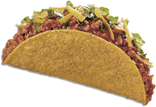
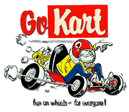 By 1962 the GoKart Manufacturing Company had gone bankrupt. The company had grown so fast in the five years it existed that it financially over-extended itself into bankruptcy. By 1962 the GoKart Manufacturing Company had gone bankrupt. The company had grown so fast in the five years it existed that it financially over-extended itself into bankruptcy.
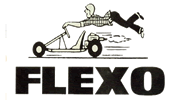 The Flexo Products company in Los Angeles, a newer and much smaller catalog like STEEN’S, purchased The GoKart Manufacturing Company’s patents, tool and dies for all their GoKarts and Mini Bikes. |
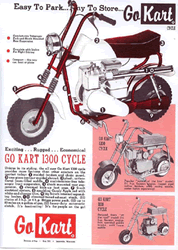
The Fox Corporation (GoKarts and Mini Bikes Mfg.) bought the GoKart trademark name and Logo. |
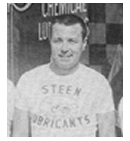
John Steen now decided it was time for him to manufacture his own mini bike. John based his decision on the large number of orders STEEN’S Chemical and Lubricants had received for Mini Bikes. Everyone was crazy about GoKarts and there were hundreds of companies competing for the GoKart market, but not that many Mini Bike companies. John was a motorcycle rider not a race car driver… so it just seemed to fit.
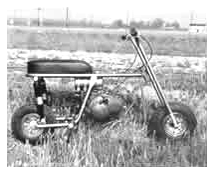 In early 1963, John Steen builds his own brand of mini bike. (At this point we are not sure who designed the first In early 1963, John Steen builds his own brand of mini bike. (At this point we are not sure who designed the first  , ,  , ,  and and  Mini Bikes.) The first STEEN’S Mini-Bikes were painted Metallic Gold, bolted together and simply constructed for shipping, but they were based on years of cross-country racing experience. (John Steen did carried the number “1” plate for lightweight desert racing in Southern California in the 50’s before his accident). When the Mini Bike was done John was still without a trademark name for his mini bike and they were built Mini Bikes.) The first STEEN’S Mini-Bikes were painted Metallic Gold, bolted together and simply constructed for shipping, but they were based on years of cross-country racing experience. (John Steen did carried the number “1” plate for lightweight desert racing in Southern California in the 50’s before his accident). When the Mini Bike was done John was still without a trademark name for his mini bike and they were built 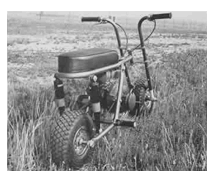 before any sales program had begun. Lynn being the ad man for STEEN’S (and still the Editor of Rod and Custom) informed John that he had to have a name for his new mini bike within a day or he would haved to re-file for a new trademark name. At the same time John had come down with the Hong Kong flu and was burning with fever. Enroute to the doctor’s office he racked his mind for a name. Semi-delirious, he looked down the street and saw a large sign that stood on top of a Mexican restaurant and advertised “ before any sales program had begun. Lynn being the ad man for STEEN’S (and still the Editor of Rod and Custom) informed John that he had to have a name for his new mini bike within a day or he would haved to re-file for a new trademark name. At the same time John had come down with the Hong Kong flu and was burning with fever. Enroute to the doctor’s office he racked his mind for a name. Semi-delirious, he looked down the street and saw a large sign that stood on top of a Mexican restaurant and advertised “ ’s The Mexican Sandwich”. When John called from the doctor’s office Lynn asked him if he had come up with a name yet. John told him “It’s A ’s The Mexican Sandwich”. When John called from the doctor’s office Lynn asked him if he had come up with a name yet. John told him “It’s A  !” Lynn filed the papers for the trademark. !” Lynn filed the papers for the trademark.
Lynn brought in Donal Jolley, another Rod and Custom graphic artist to help out with the work load. With Lynn and John’s direction, Donal created the Mexican Bean on the  Mini Bike .The line “It’s a Mini Bike .The line “It’s a  ” was based on the original phone call that John made to Lynn to tell him the name of the new mini bike. Donal also came up with the lettering style for the name ” was based on the original phone call that John made to Lynn to tell him the name of the new mini bike. Donal also came up with the lettering style for the name  . Check out Donal's web site with his current art work at http://www.jolleyart.com/index.cfm . Check out Donal's web site with his current art work at http://www.jolleyart.com/index.cfm
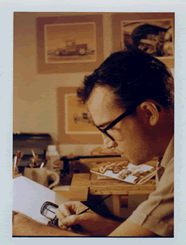 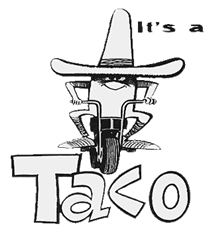 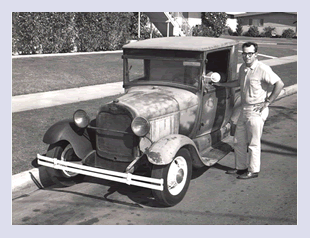
Donal Jolly 1929 Ford pick up Rod and Custom Project Car
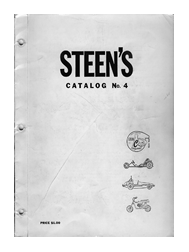 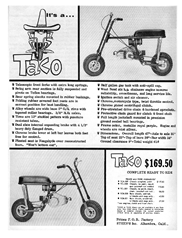
STEEN’S Chemical and Lubricants company catalog #4, introduced the  Mini Bike. Just one original design frame model to choose from, but there were various engines, shocks, and rim opinions. A very similar package to the GoKart Mfg. company’s Enduro and Scrambler Mini Cycles. Through these change of events John Steen starts building The Mini Bike. Just one original design frame model to choose from, but there were various engines, shocks, and rim opinions. A very similar package to the GoKart Mfg. company’s Enduro and Scrambler Mini Cycles. Through these change of events John Steen starts building The  Mini Bikes. Mini Bikes.

The Color PURPLE
The first  ’s were painted Metallic Gold a very popular GoKart color, but John knew it just wasn’t right. Lynn knew the right color. Back In 1948 Lynn had seen the Doane Spencer at the First Hot Rod Car Show in Los Angeles. In 1949 we'll Lynn was in the Air Force and stationed in Ohio on his off duty time Lynn had started building a 32 channeled roadster inspired by the Doane Spencer. ’s were painted Metallic Gold a very popular GoKart color, but John knew it just wasn’t right. Lynn knew the right color. Back In 1948 Lynn had seen the Doane Spencer at the First Hot Rod Car Show in Los Angeles. In 1949 we'll Lynn was in the Air Force and stationed in Ohio on his off duty time Lynn had started building a 32 channeled roadster inspired by the Doane Spencer.
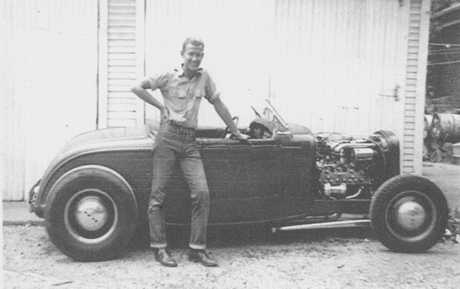
Lynn Wineland 1950
In 1951 at the Indianapolis Hot Rod Show Lynn exhibitived his 32. Lynn's 32 was originally painted black and all the Hot Rods of the day were black or red. Lynn wanted his Hot Rod to be different. So he mixed up his own custom Metallic Purple and painted his 32.
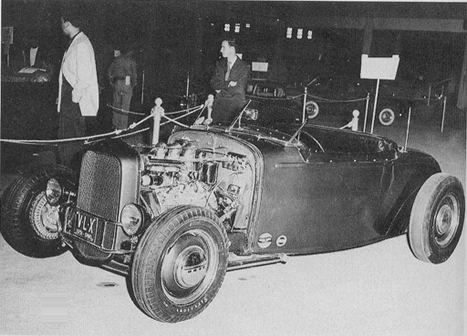
1951 Indianapolis Hot Rod Show Lynn's Metallic Purple 32
Lynn had extra paint that he had saved and he knew this was the color for the new  ’s. He showed John the color and from that moment on ’s. He showed John the color and from that moment on  Mini Bikes would be recognized and remembered mostly for this Metallic Purple… and of course the cast Mini Bikes would be recognized and remembered mostly for this Metallic Purple… and of course the cast  aluminum chain guard cover (also designed by Lynn in 1969). Check out more on Lynn at http://www.kustomrama.com/index.php?title=Lynn_Wineland aluminum chain guard cover (also designed by Lynn in 1969). Check out more on Lynn at http://www.kustomrama.com/index.php?title=Lynn_Wineland

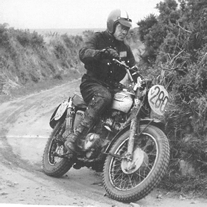 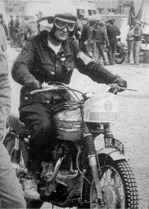
In the summer of 1964 John and Lynn headed to Europe for the 39th annual International Six Days Trial hosted by East Germany. The ISDT was a test of skill and endurance in all terrain motorcycle riding. This was the biggest international motorcycle event of the day hosted by a new country every year. Even at the height of the Cold War this event was so important that the Russian would enter riders and host event some of the years.
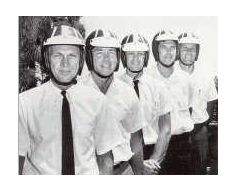 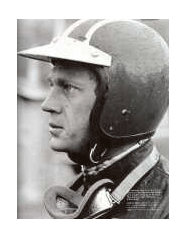
John had join the American team and Lynn of course would photo documented the race as he had for the last 3 years. This year would be highly publicized because of another new American team member, Steve Mc Queen.
After the race John headed back for the states. Lynn stayed in Europe for a little sight seeing before coming home. While in Italy Lynn met with the Ceriani family and had setup the North American distribution of Ceriani forks and shocks for STEEN’S. This would become a great addition to the supply of Hi-performance motorcycle parts STEEN was now offering.
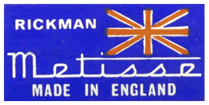 In the summer of 1965 John return to Europe to ride in the 40th annual International Six Days Trial, and Lynn return to document the event once again. This year was hosted by Great Britain in the Isle of Man. Before coming home Lynn went to London to do some sight see. During Lynn visit he had meet the Rickman brothers and this time had secured the North American distribution of Rickman Metisse parts and accessories. Once again this was going to be a great addition to the catalog of equipment offered by STEEN’S. In the summer of 1965 John return to Europe to ride in the 40th annual International Six Days Trial, and Lynn return to document the event once again. This year was hosted by Great Britain in the Isle of Man. Before coming home Lynn went to London to do some sight see. During Lynn visit he had meet the Rickman brothers and this time had secured the North American distribution of Rickman Metisse parts and accessories. Once again this was going to be a great addition to the catalog of equipment offered by STEEN’S. |

Finally Home
 |
By 1965 three new models are introduced. The  , ,  and and  . . mini bikes are selling faster then John can manufacture them. STEEN’S C oil is still a hot seller and sales from the accessory side of the STEEN’S catalog are through the roof. At this point John is making more money than he knows what to do with, but doesn’t have any time to spend his new wealth. The building that STEEN’S is operating out is to small and it’s time to move again, hire more employees and incorporate STEEN’S. mini bikes are selling faster then John can manufacture them. STEEN’S C oil is still a hot seller and sales from the accessory side of the STEEN’S catalog are through the roof. At this point John is making more money than he knows what to do with, but doesn’t have any time to spend his new wealth. The building that STEEN’S is operating out is to small and it’s time to move again, hire more employees and incorporate STEEN’S. |
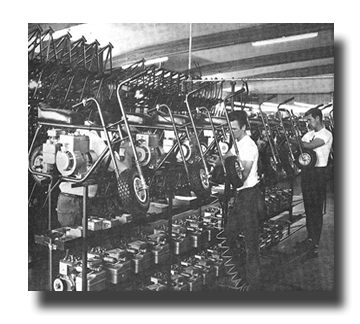 |
 |
This time John decides to build his own building, a big one that he and Lynn design for the assembly of mini bikes. This would be the last building STEEN’S (location #3 1635 west valley Blvd ) would move to. |

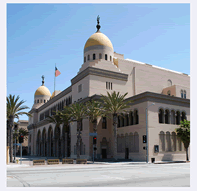
|
In the summer of 1966 John ran in to an old family friend Jack Poetker at a car show at the Shirian Auditorium. Jack had just finished his time in Vietnam with the Army. John had worked for Jack's father who ran a construction company in the 50's and John knew how skilled and creative Jack could be, and asked him to come to work as the shop foreman. Lynn only had been working for John as a freelance employee, but in October of 1966 John convinces Lynn to leave Rod and Custom and to start working for him full time. Lynn agrees to make the move. When Jack came to work for STEEN’S he redesign the  Mini Bikes and turn them in to a sturdier welded frame bikes. Jack and Lynn are responsible for the Mini Bikes and turn them in to a sturdier welded frame bikes. Jack and Lynn are responsible for the  , ,  , and later , and later  , and T100. , and T100.
|

|
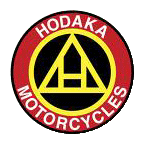
In 1967 STEEN’S discountinues the series I TACO and the STEEN’S is now selling Hodaka motorcycles, and with all of these motorcycle parts and accessories John decides to build his own 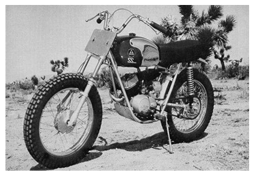 custom light weight dirt bikes. Taking a stock Hodaka and stripping it down to the bare frame making some adjustments to it adding Ceriani forks and shocks, Rickman Metisse handle bars, new exhaust, skid plate, and a new metallic blue paint job, John has made the first and one of the greatest light weight off-road bikes ever. The HODAKA SS. John Steen is now what dirt bikes are to what Carroll Shelby is to Mustang. custom light weight dirt bikes. Taking a stock Hodaka and stripping it down to the bare frame making some adjustments to it adding Ceriani forks and shocks, Rickman Metisse handle bars, new exhaust, skid plate, and a new metallic blue paint job, John has made the first and one of the greatest light weight off-road bikes ever. The HODAKA SS. John Steen is now what dirt bikes are to what Carroll Shelby is to Mustang.

The Highest From of Flattery
 Mini Bikes were becoming so popular that Japanese motorcycle companies were buying Mini Bikes were becoming so popular that Japanese motorcycle companies were buying  ’s and sending them back to Japan to be examined and copied. When the first 10 production model ’s and sending them back to Japan to be examined and copied. When the first 10 production model  s were made, Norm Reaves Honda bought the first ten and sent them back to Japan. Honda and Kawasaki would copy two models. Honda would copy the s were made, Norm Reaves Honda bought the first ten and sent them back to Japan. Honda and Kawasaki would copy two models. Honda would copy the  with the Z50 and Kawasaki would first copy the with the Z50 and Kawasaki would first copy the  with the Coyote and then the with the Coyote and then the  with the MT1. with the MT1.
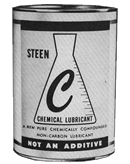 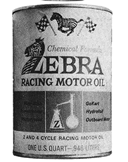 Other domestic Companies would also copy STEEN’S like Jan/Ho Industries. Copying the Other domestic Companies would also copy STEEN’S like Jan/Ho Industries. Copying the  , and , and  with their Zebra mini bikes. Jan/Ho even copied STEEN’S C oil with their own chemically formulated Zebra racing oil right down to the chemical flask logo on the can. In 1967 STEEN’S Chemical and Lubricants is now incorporated and the company name is changed to STEEN’S Inc. Now John has more time to enjoy himself and spend some of his wealth on a new FERRARI Daytona. with their Zebra mini bikes. Jan/Ho even copied STEEN’S C oil with their own chemically formulated Zebra racing oil right down to the chemical flask logo on the can. In 1967 STEEN’S Chemical and Lubricants is now incorporated and the company name is changed to STEEN’S Inc. Now John has more time to enjoy himself and spend some of his wealth on a new FERRARI Daytona.

This is the End My Friend
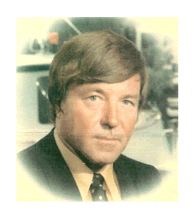
John will go on to build 12 different models before selling the company in 1969 to “Suburban Gas of Pomona”. |
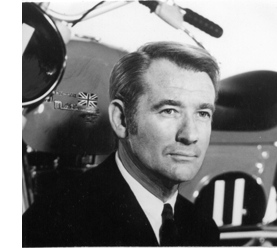
Lynn Wineland will leave STEEN'S around 1971 after the mismanagement and lack of understanding of the vehicles and the hobby.
|
|
In 1971 company is stilled called STEEN’S and they will produce three new models. The Super T100, T102, and the F85 Matterhorn. These models are not Mini Bikes, but Mini Trail Bikes made to compete with the Honda Z50 and the Kawasaki KT1. These three new models are the last bikes STEEN’S will ever introduce for this market. 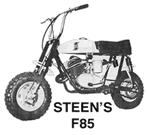 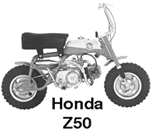 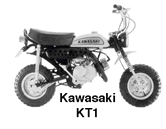 |
The GoKart and Mini Bike 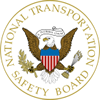 craze is now on the down swing. In the 70’s, the National Transprtation Safety Board was giving the GoKart and Mini Bike hobby a bad name. |
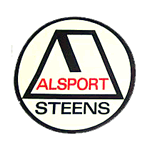 In 1972 Suburban Gas of Pomona decides to sell the company. They sell to Alsport an east cost company that wanted to make a move out west. Alsport now changes the name to Alsport/STEEN. In 1972 Suburban Gas of Pomona decides to sell the company. They sell to Alsport an east cost company that wanted to make a move out west. Alsport now changes the name to Alsport/STEEN.
|
|
 One side note to this sale was Alsport had no interest in the STEEN’S C synthetic oil and TuGee bought the rights to STEEN’S C. Another funny point about synthetic oil is Chevron is listed on internet searches as the first to market and produce a complete range of 100% synthetic oil in the mid 1960s. John was marketing and producing a 100% synthetic oil back in the mid 50’s. One side note to this sale was Alsport had no interest in the STEEN’S C synthetic oil and TuGee bought the rights to STEEN’S C. Another funny point about synthetic oil is Chevron is listed on internet searches as the first to market and produce a complete range of 100% synthetic oil in the mid 1960s. John was marketing and producing a 100% synthetic oil back in the mid 50’s. |
| Alsport/STEENS, with no new R and D or new model mini bikes or mini tail bike is unfortunately losing out to the new cheaper and better mini trail bikes (not mini bikes) and motorcycles the Japanese started mass-producing. Alsport/STEEN would close it doors in late 1976 and, just like the Muscle Cars, this was the end of an era. |
|

|